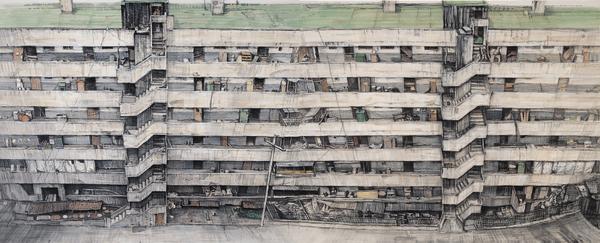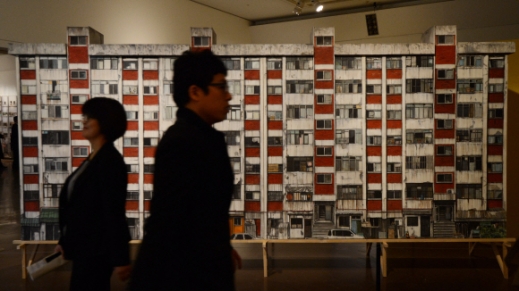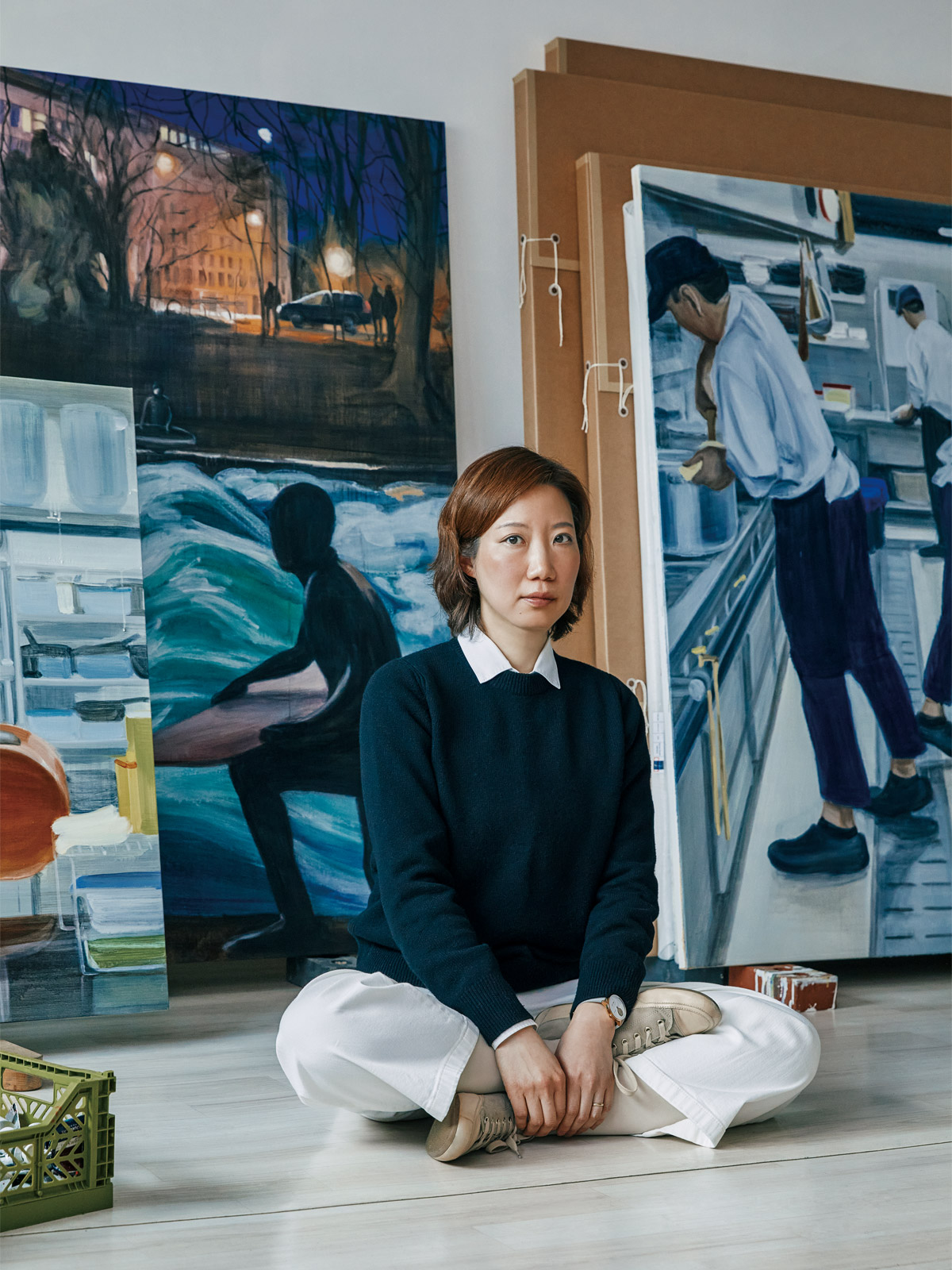Jaeho Jung
(b. 1971) is an artist who captures the process of urban development and
decline during Korea's modernization, as driven by state initiatives, through
painting. He meticulously observes and portrays urban landscapes over extended
periods, including Seoul's nightscapes, areas threatened by redevelopment, and
newly constructed buildings.

Jaeho Jung, Cheongun Monument 1, 2004 ©Jaeho Jung
Jaeho Jung has consistently depicted urban
landscapes on his canvas, beginning with his first solo exhibition in 2001,
where he showcased panoramic nightscapes of Seoul. Since 2004, the artist has
sought out old apartments, houses, and buildings constructed during the 1960s
and 1970s.
The Cheongun Monument
(2004) series was the first apartment-themed work he presented, set against the
backdrop of Cheongun Citizen Apartments in Jongno-gu. There, Jung discovered
traces left by the residents who had lived in and departed from the building
due to redevelopment, alongside the aging exterior of the apartments.

Jaeho Jung, Cheongun Monument 3, 2004 ©Jaeho Jung
Jaeho Jung meticulously and realistically
depicted the traces of time and the remnants of people's lives left behind in
the apartments, almost as if recording them. In this process, he used
traditional Korean painting materials like hanji (Korean paper) and ink,
capturing the faded, profound atmosphere characteristic of Eastern painting to
emphasize the fleeting existence of buildings that still stand but are soon to
disappear. Simultaneously, he employed acrylic paint, a Western medium, to
render the textures of old stains and grime on the walls with great precision.
 Jaeho Jung, Riverside
Hotel - Joongsan Pilot Apartment, 2005 ©Jaeho Jung
Jaeho Jung, Riverside
Hotel - Joongsan Pilot Apartment, 2005 ©Jaeho JungBeginning
with Cheongun Monument, Jaeho Jung delved deeply into the
architectural and urban history of Seoul, continuing his work on various
citizen apartments in the city. In 2005, he presented the results of his
exploration in the exhibition “Old Apartment Building” at the Kumho Museum of
Art.
The
new apartment works displayed in this exhibition revealed a shift in tone by
aligning the facades of buildings with the large-scale canvases. For instance,
the Riverside Hotel - Joongsan Pilot Apartment (2005) series
filled the horizontal frame with the full front facade of the apartment
building, extending across the width of the canvas. This approach marked a
departure from his earlier apartment works, which utilized diagonal
compositions or included background elements.
 Jaeho Jung, Riverside
Hotel - Joongsan Pilot Apartment, 2005-2014,
Installation view of “The Republic of Apartments” (Seoul Museum of History,
2014) ©The Seoul Shinmun Daily
Jaeho Jung, Riverside
Hotel - Joongsan Pilot Apartment, 2005-2014,
Installation view of “The Republic of Apartments” (Seoul Museum of History,
2014) ©The Seoul Shinmun DailyThrough
his paintings of apartments, a symbol of modernization, Jaeho Jung developed a
deep interest in the hidden side of urban landscapes shaped by rapid economic
growth driven by state-led development. Viewing his paintings as a kind of
"paper monument," Jung sought to commemorate and document old
apartments that had been disappearing under the logic of redevelopment.
Starting in 2005, these paper monuments began to take the form of reliefs or
three-dimensional works.
Jung’s
work on old apartments is also intertwined with his personal memories. While
continuing these projects, the artist often recalled the old apartment where he
spent his childhood. The scenes he encountered within the aging apartment
complexes at risk of disappearing were reflections of his past, the present of
those he knew, and their shared future.

Jaeho Jung, Modern Arcade, 2007 ©Jaeho Jung
Meanwhile,
Jaeho Jung's Ecstatic Architecture (2006–2007) series, first
unveiled at Kwanhoon Gallery in 2007, focuses on decades-old buildings in
Seoul's Jeong-dong district that were constructed during the city's
modernization period. Through this series, the artist sought to express the
sense of ecstasy he felt from the traces of time embedded in these buildings,
which were on the brink of disappearing from history.
The
four buildings featured in Ecstatic Architecture—Cheonggye
Tower, Modern Arcade, Jongno Building, and Yongsan Hospital—are based on real
structures but meticulously reimagined through the artist's detailed
observations and brushstrokes. For instance, the vibrant polka-dot patterns
covering the facade of Modern Arcade (2007) were entirely
added by the artist. In this way, Jung deeply engaged with urban architecture,
building a sense of connection through prolonged observation and interaction,
which he then expressed in various artistic forms.

Jaeho Jung, Dome 1, 2009 ©Gallery Hyundai
In
2009, Jaeho Jung introduced the Father's Day series, an
extension of his previous works that explored old buildings destined to vanish
from history. This series took a step further by reimagining spaces and objects
that existed during his father's generation but have since disappeared.
Drawing
inspiration from images of buildings from the 1950s to the 1980s, the artist
recreated them through his paintings. However, rather than simply restoring
them as they once were, Jung employed a process of editing and reconstructing
based on various contextual details about the time and place where these
buildings existed. The result was a depiction of an ambiguous, fictional
time-space that blends memory, history, and imagination.
 Jaeho
Jung, April,
2011 ©Gallery
SoSo
Jaeho
Jung, April,
2011 ©Gallery
SoSoJung’s
Planet series, presented at his 2011 solo exhibition at
Gallery SoSo, also incorporates images sourced from the internet. At the time,
Jung focused on landscapes from 1960s Korea, a period when the nation dedicated
itself to economic revival in the aftermath of the war. To achieve this, he
utilized a wide range of visual materials, including official archival
photographs, corporate promotional images, advertisements, personal photos
taken by U.S. military personnel stationed in Korea, and video clips from Korea
News (Daehan News).
The
images he collected reflect traces of corporate economic activity and Korea's
dependency on the West during that era. Subjects included the Sewoon Plaza,
Korea's first mixed-use residential and commercial building; scenes of Hyundai
Motor's Ulsan factory in its early days; the shop window of a prosthetics
store; and astronaut models displayed at a science exhibition.
 Jaeho
Jung, Bright
Future, 2011
©Gallery
SoSo
Jaeho
Jung, Bright
Future, 2011
©Gallery
SoSoJaeho Jung combined and arranged various
images scattered across different times and spaces to compose a single scene,
or transformed these landscapes into depictions of decay or ruin. He also added
color and painterly textures to the originally black-and-white photographs.
These interventions and modifications by the artist emphasize that the history
represented is not merely a frozen moment in time but an essential past that
continues to underpin and influence the present. Through this process, Jung highlights
the enduring relevance of these historical narratives.

Jaeho Jung, Youth, 2012 ©Gallery Hyundai
Jaeho Jung's reconstructed paintings, based
on archival materials, are often referred to as "archive paintings."
This series reflects how his interest in old buildings expanded to encompass
the social and historical contexts of the periods during which these structures
were erected.
One notable work, Youth
(2012), is inspired by a black-and-white photograph from the late 1970s
depicting young men detained for having long hair, awaiting haircuts during a
crackdown. In Jung's painting, the four youths are reimagined wearing space
helmets, standing on the surface of the moon. By juxtaposing such disparate
contexts, the artist presents a fragmented yet evocative representation of a
period when personal freedoms were suppressed.
 Jaeho Jung, A
Ball of a Dwarf, 2018 ©MMCA
Jaeho Jung, A
Ball of a Dwarf, 2018 ©MMCAAfter a series of archive paintings, Jaeho
Jung focused on the fact that the government encouraged the citizens of a
developing country to dream of a bright future through advancements in science
and technology. A Ball of a Dwarf (2018), shown in the
“Korea Artist Prize 2018” exhibition hosted by the National Museum of Modern
and Contemporary Art, Korea, captures a view of Seoul from Sewoon Plaza, built
between the 1960s and 1970s.
At the time, Sewoon Plaza was regarded as a
utopian space and a symbol of capitalist industrialization. The shops and
buildings lining Cheonggyecheon, with Sewoon Plaza at its core, have now become
dwarfed by the towering skyscrapers that surround them. Jung captures this
ruinous landscape at the heart of Seoul, while an unrealistic “rocket” is drawn
in the upper part of the canvas.
The rocket soaring into the sky symbolizes
a collective dream that cannot be realized in today’s reality. This landscape
is not just a representation of Seoul’s streets but a portrait of Korean
society, transitioning from an era of dreaming the impossible during economic
growth and crisis to one that now dreams of what is possible.

Jaeho Jung, A Place to Hear Sounds, 2020 ©Sahngup Gallery
In this way, Jaeho Jung has discovered the continuity of the past within the present, capturing it in the landscapes of our society and documenting it through his unique pictorial language. His work portrays past events, buildings, objects, and people, prompting reflection on history while also showing how it relates to the current reality.
"Rather than having a specific subject to paint, I hope that 'something'—something that cannot be reduced to a single meaning, perhaps something like infinity—can be contained in my work." (Jaeho Jung, Artist's Note)
 Artist Jaeho Jung
©MMCA
Artist Jaeho Jung
©MMCAJaeho
Jung graduated with both a bachelor's and master's degree in Eastern Painting
from Seoul National University. He is currently serving as a professor in the
Department of Painting at Sejong University. Jung was nominated for the Korea
Artist Prize in 2018 by the National Museum of Modern and Contemporary Art. His
solo exhibitions include “How long have I been I here” (CHOI&CHOI Gallery,
2023), “Spear and Heap” (Sahngup Gallery, 2020), “Heat Island” (INDIPRESS,
2017), “Planet” (Gallery SoSo, 2011), and “Father's Day” (Gallery Hyundai,
2009).
Jung
has also participated in numerous group exhibitions at institutions such as the
OCI Museum of Art (2017), Cheongju Museum of Art (2016), Ilmin Museum of Art
(2015), Arko Art Center (2014), and Buk-Seoul Museum of Art (2014). His works
are housed in major collections, including the National Museum of Modern and
Contemporary Art, Korea, Seoul Museum of Art, Busan Museum of Art, Jeju Museum
of Art, Kumho Museum of Art, and OCI Museum of Art.
References
- 올해의 작가상, 정재호 (Korea Artist Prize, Jaeho Jung)
- 한국문화예술위원회, 작가 조사-연구-비평 : 정재호 (Arts Council Korea, Artist Reserch-Study-Critique: Jaeho Jung)
- 월간미술, 우정아 - 정재호의 헤테로토피아
- 한국아파트신문, 친구 같던 아파트가 사라졌다, 그를 위해 붓을 들었다 [아파트, 예술이 되다 ②], 2022.07.10
- 국립현대미술관, 정재호 | 황홀의 건축-청계타워, 현대오락장, 종로빌딩, 용산병원 | 2006 – 2007 (National Museum of Modern and Contemproary Art Korea (MMCA), JUNG Jaeho | Ecstatic Architecture-Cheonggye Tower, Modern Arcade, Jongno Building, Yongsan Hospital | 2006 – 2007)
- 현대화랑, 아버지의 날 (Hyundai Hwarang, Father’s Day)
- 갤러리소소, 혹성 (Gallery SoSo, Planet)
- 국립현대미술관, 정재호 | 난장이의 공 | 2018 (National Museum of Modern and Contemproary Art Korea (MMCA), JUNG Jaeho | A Ball of a Dwarf | 2018)

















